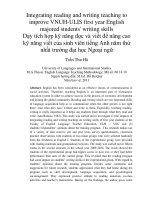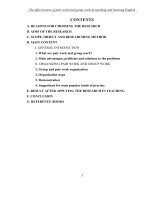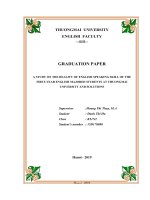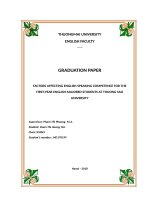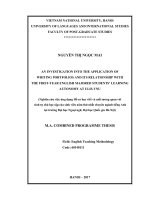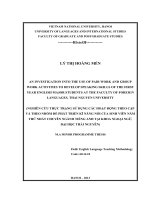Improving first year english majored studens listening skills with interactive activities of pair work, group work and teachers roles at long an teacher training college
Bạn đang xem bản rút gọn của tài liệu. Xem và tải ngay bản đầy đủ của tài liệu tại đây (513.4 KB, 100 trang )
NATIONAL UNIVERSITY OF HO CHI MINH CITY
UNIVERSITY OF SOCIAL SCIENCE AND HUMANITIES
Faculty of English Linguistics and Literature
Postgraduate Program
_________________________________
DƯƠNG CHÁNH NGUYỄN
IMPROVING FIRST-YEAR ENGLISH-MAJORED STUDENTS’
LISTENING SKILLS WITH INTERACTIVE ACTIVITIES OF
PAIR-WORK, GROUP-WORK AND TEACHER’S ROLES AT
LONG AN TEACHER TRAINING COLLEGE
M. A. THESIS
Subject Area: TESOL
Code: X A 02025
Supervisor: NGUYỄN HUỲNH ĐẠT, M.A.
HO CHI MINH CITY – 2007
2
STATEMENT OF AUTHORSHIP
Apart from where reference is made in the text of the thesis, this thesis
does not contain any material published or extracted in the whole, or in part
from a thesis by which I have qualified for or been awarded another degree
or diploma.
No other person’s work has been used without due acknowledge in the
thesis.
This thesis has not been submitted for the award of any degree or
diploma in any tertiary institution.
i
ACKNOWLEDGEMENTS
I would like to express my sincerest gratitude to all my lecturers at
HCM City University of Social Science and Humanities-Faculty of English
Linguistics and Literature-Postgraduate Program, for their interesting and
beneficial lectures without which I would hardly have written this thesis.
I own special thanks to my supervisor, Mr. Nguyen Huynh Dat, for
his careful reading of the manuscript, guidance, comments, support, and
constant encouragement. If it had not been for this great contribution, I
would not have fulfilled this thesis.
I would like to take this opportunity to thank all the staff members of
Post Graduate Department for their enthusiastic encouragement during the
time I did my thesis.
I am also grateful to all of my colleagues at LONG AN Teacher
Training College for their help, and comments on my lessons.
Finally, I wish to thank LONG AN Teacher Training College
administration staff who offered me lots of opportunities to attend the
lectures as well as to do the thesis.
HCM city, May 2007
Duong Chanh Nguyen
ii
ABSTRACT
The present thesis investigates the effect of interactive activities of
pair-work, group-work, and teacher’s roles on improving students’ listening
skills to English-majored first-year students at Teacher’s Training College of
Long An. The research project was carried out based on the hypothesis that
college students would benefit from those activities to improve their
listening skills in English language acquisition, and that it is feasible and
necessary for language teachers to organize those activities in their
classrooms. The research involved two groups of students, the control group
and experimental group, from two different classes and two different
teachers in charge. There are two main stages in the research, one for
Problem Identification which is called stage 1, one for Trying-outImprovement, stage 2. In each stage, the students of the two groups are
tested with the same listening test. The time interval between the two stages
was five months during which the experimental group received listening
lessons with the interactive activities of pair-work, group-work, and
teacher’s roles, whereas the control group didn’t. The data for comparison
and reflection were collected in term of marks, and analyzed in form of a
mark scales. To support the research, a huge collection of information and
theory had been exploited from books, other research, internet related to the
field as the theoretical background.
iii
TABLE OF CONTENTS
STATEMENT OF AUTHORSHIP
ACKNOWLEDGEMENTS
ABSTRACT
TABLE OF CONTENTS
ABBREVIATION
LIST OF FIGURES, TABLES AND PHOTOGRAPHS
GLOSSARY OF USEFUL EFL TERMS in THE THESIS
Page
Chapter One: INTRODUCTION
1
1. The rational for the research thesis
3
2. Problem statement
4
3. Research Questions
5
4. Why is student-to-student interaction?
6
5. Why is pair-work, group-work?
6
6. Scope of the research
6
7. Organization of the research
8
Chapter Two: LITERATURE REVIEW
1. What is interaction?
9
2. Communication in the classroom.
10
3. Collaborative learning
11
4. Language learning is interactive
12
5. What is pair-work, group-work?
13
6. Advantages of pair-work and group-work
14
iv
6. 1. Pair-work and group-work encourage communication,
cooperation, and generate interactive learning.
14
6.2. Pair-work, group-work offers learners confidence and
affective climate.
14
6.3. Pair-work, group-work promotes learners’
responsibilities.
15
6.4. Pair-work, group-work is a step to individualizing
instruction.
15
7. Excuses for avoiding pair-work and group-work.
16
7. 1. The teacher is no longer in control of the class.
16
7.2. Students will use their native language.
17
7.3. Students' errors will be reinforced in small groups.
18
7.4. Teachers cannot monitor all pairs, groups at once.
19
7.5. Some learners prefer to work alone.
19
8. How to do pair, group work.
8.1. Special consideration for pair- work and group-work.
8.1.1. How to create pair, group tasks that require
20
20
21
interdependence
8.1.2. Be conscious of group size.
22
8.1.3. How to form pairs, groups.
22
8.1.4. How to get the class’s attention when students 24
are working in their groups.
8.1.5. How to control the noise.
25
8.1.6. How to help students to work well in pairs,
26
groups.
v
8.1.7.What if some groups finish earlier than others? 26
8.1.8. How long should pairs, groups stay together?
27
8.1.9 How to end pairs, groups.
28
8.1.10. What percentage of the time should
28
cooperative learning be used?
8.2. Stages in organizing pair-work and group-work.
29
8.2.1. Before pair-work and group-work
30
8.2.2. While pair-work and group-work.
30
8.2.3. After pair-work and group-work
31
9. Checklist to remember for group-work and pair-work activities 31
10. Problematic issues in pair-work and group-work
10.1. If advanced learners dominate
32
33
10.2. If advanced learners seem bored or beginners seem lost
10.3. If classes are too big or too diverse
34
10.4. If learners use their native language
34
10.5. If students do not want in pairs, groups.
35
10.6. If students are frequently absent students.
36
11. What are teacher’s roles?
37
11.1. The teacher as a monitor.
37
11.2. The Teacher as a controller
38
11.3. The Teacher as a director
39
11.4. The Teacher as a manager
39
11.5. The Teacher as a facilitator
39
11.6. The Teacher as resource
40
11.7. The Teacher as an observer (watching what the groups 40
are doing right).
vi
11.8. The teacher as an evaluator (giving feedback)
12. Listening process
41
41
12.1. Pre-listening
42
12.2. While-listening
43
12.3. Post-listening
44
12.4. Contrasting Effective and Ineffective Listening Stages.
Chapter Three: METHODOLOGY
1. Overview
47
2. The listening test and the test score
48
3. Research Hypotheses.
49
4. The context and setting of the research
49
5. Participant
50
6. Implementation
52
6.1. Problem Identification
52
6.2. Trying- out and Improvement
53
Chapter Four: RESULTS
56
Chapter five: DISCUSSION and RECOMMENDATIONS
59
1. Discussion.
59
2. My listening lesson plans.
60
3. The developing of a listening lesson with pair-work and groupwork activities.
61
4. Analysis of teacher’s roles in pair-work and group-work.
65
5. Description of a listening lesson with pair-work
66
and group-work activities
vii
6. Checklist for successful group-work and pair-work activities
68
7. Do we really have to work in groups, pairs in
69
teaching listening lessons?
8. Teaching listening and language skill improvement
Chapter Six: CONCLUSION and FUTURE RESEARCH
71
74
1. Review of the findings in the research
74
2. General comments
75
3. Future research
75
BIBLIOGRAPHY
76
Appendix A : The listening test
Appendix B: Sample of listening lesson plans
viii
LIST OF TABLES
Table 1. Comparison of students’ background in the experimental and control group
Table 2. The marks and their percentage of the control group in stage 1.
Table 3. The marks and their percentage of the experimental group in stage 1.
Table 4. The marks and their percentage of the control group in stage 2.
Table 5. The marks and their percentage of the experimental group in stage 2.
Table 6 . Comparison of marks and their percentage of the control group in two stages.
Table 7 . Comparison of marks and their percentage of the experimental group
in two stages.
Table 8. The advantages of pair-work and group-work
Table 9. Analysis of teacher’s roles in pair-work and group-work.
Table 10. The sample of a listening lesson plan.
Table 11. Checklist for successful group-work and pair-work activities
ix
ABBREVIATION
( In Alphabetical Order)
ESL
English as a Second Language
EFL
English as a Foreign Language
STT
Student Talking Time
TTT
Teacher Talking Time
Chapter One
INTRODUCTION
Listening comprehension has received considerable attention in the
fields of applied linguistics, psycholinguistics and second language pedagogy
during the last two decades (Rost, 1992; Underwood, 1989; Ur, 1984). Results
of the large body of research have shown that listening is not a passive process,
in which the listener simply receives a spoken message, but rather a complex
cognitive process, in which the listener constructs the meaning using both his
linguistic and non-linguistic knowledge. The importance of the listeners’
cognitive and social judgments in the process of listening, in addition to the
linguistic knowledge, has been especially emphasized (Rost, 1992).
Although most of the findings relevant to understanding how listening
operates come from research into listening in small quantities, many of the
conclusions have had important implications for the teaching of listening in the
foreign language. It is widely recognized today that listening is an active skill,
or rather, a cluster of various sub-skills, which are both learnable and
teachable. Listening is regarded as an essential element of foreign language
proficiency, and thus plays an important role in foreign language programmes.
Various methodologies for the teaching of listening have emerged (such as
Brown, 1991; Ur, 1984). These have had a considerable influence on course
design and textbook writing, materials for teaching listening (authentic vs.
constructed), types of listening tasks, especially in terms of features of ways of
raising learner awareness of the listening process and effective strategies for
listening, stages in listening activities, and integrating listening with other
language skills. The importance that listening receives in foreign language
1
pedagogy today is reflected at various levels: in one form or another, listening
is present in syllabuses, course books and teaching materials available on the
market, general proficiency language exams and is even the main focus of
specialized courses, such as academic listening, communicative listening.
However, the teaching of the listening skill has been long overlooked in
English language teaching at Teacher Training College of Long An Province.
There is a lack of research and literature on the teaching of listening, and this
skill is also considerably neglected in the practice of teaching English. The
development of all four language skills is outlined as one of the goals of
foreign language teaching in the official national syllabus. However, a closer
analysis reveals that there is no systematic approach to the teaching of listening
at any level of instruction, since there are no activities or materials that
specifically focus on the development of this skill. This implies that there is an
underlying assumption that listening skills will develop on their own.
This gap between methods for teaching listening and the neglect of this
skill in the teaching of English at Teacher Training College of Long An
Province was the starting point for an experimental study of listening skills
among college students of English. The aim of the study was to compare the
improvement of listening skills in two groups of first-year students of English:
one receiving interactive activities of pair-work and group-work together with
teacher’s roles in their listening lessons during one semester and the other
attending listening class without those activities
2
1. The rational for the research thesis
We can see clearly that the present situation of the teaching of listening
in most colleges is not very interactive. The traditional way of teaching
listening, such as introducing some new difficult words, listening to the tape
again and again and then giving correct answers, is still predominant. It is not
difficult for us to see how much “damage” such a listening class is to students.
Such an approach to “teaching” listening is more like “testing” listening,
because students are simply exposed to a continuation of listening texts on a
tape, and then are tested how much they have understood in terms of a lot of
comprehension exercises rather being improved their language skills. As a
result, many students have not been able to develop their English language
skills, and students’ passive attitude has kept them from making much progress
in listening in general, and in English language learning in particular. In other
words, students have not got opportunities to use new language they have
learnt. One of the reasons for the above concerning problem is that language
teachers lack the skills of language classroom management. Those skills are
related to how to organize the classroom in which such activities as
communication, interaction, collaboration, pair-work, group-work take place.
My controversy on this field is whether interactive activities of pairwork and group-work together with teacher’s roles in listening lessons would
bring benefits to the improvement of listening skill in particular and English
language learning in general, and whether English teachers are able to organize
those activities in terms of classroom management. The aim of my thesis is to
prove that it is completely necessary to organize interactive activities in
listening lessons, and to suggest some ways to perform the work. In addition,
doing the thesis is certainly a golden opportunity for me to re-consider my
teaching process as well as to make me better in the field.
3
2. Problem statement
Most often, the listening lessons that students do in colleges are simply
for the eyes of the teacher and ears of the students. The so-called interactive
listening involves students listening to and with other students. There are a
number of reasons why this might be useful. Firstly, listening to other students
can give the students a clear sense of purpose and a sense of having an
audience to report their listening result - they can get feedback from other
student listeners on how far their listening has been furthered. Secondly,
listening with other students can give them a clear focus for their work.
Interactive listening lessons will involve them in asking and sharing each other
about grammar, spelling, vocabulary, phrasing, etc. and so give them the
language they have learnt and the chance to learn in a non-threatening
atmosphere.
However, my listening lessons had used to be contrary to what I have
stated above until I started performing my research. I used to keep my students
individually and silently doing the listening tasks. My class seemed to be
“listening testing” rather than “listening teaching”, and it was so passive that
the students became bored and slouched. They just opened their mouths to
speak when asked. I recognized that there was hardly any interaction in my
students, or student interaction was very, very limited. As a result, students’
marks on listening tests are very low. A lot of the students failed their listening
tests. And I always complain to the students about their result.
After I had attended the MA course on teaching methodology, exactly on
communicative approach, interactive activities, learner motivation, pair-work,
group-work,... etc. I felt very ashamed of what I have done to my students, my
lessons, and I had an idea that I really wanted my students to improve their
listening skill and their marks. And after lots of consideration and consultation
4
with my colleagues, especially with my lecturers of MA course at University of
Social Science and Humanities, I found that was due to several factors, and one
of them was my classroom management, to be exact, the lack of pair-work and
group-work as well the roles of teachers. I hadn’t organized pair-work and
group-work in my lessons. Now I'm really interested in gaining awareness of
how I manage my classroom, what goes on in my classroom activities, what
my students can do, whether my students interact with each other or not, and
how much interaction they can do, what my students gain from each lesson.
Therefore, I have decided to do the investigation on the aspect to improve my
students’ listening skills by creating more interactive activities in listening
lessons.
3. Research Questions
From these above points of view, my research on the aspect is
completely helpful to my teaching as a language teacher and doing this helps
me to pose some problems, to find some solutions so that I can improve the
students’ listening skills.
My questions are:
■ “Why don’t students interact with each other in listening lessons?”
■ “Would interactive activities of pair-work, group-work, and teacher’s
roles help improve students’ listening skills?”
5
4. Why is student-to-student interaction?
The aim of teaching a language is to help the learners to use the
language they have learned. And the best way in which the language is used in
the classroom is the interaction among learners themselves, rather than learners
to the teacher. Therefore, student interaction takes an important part in
language teaching. H. Douglas Brown has stated that “Teacher’s most
important job might be to create the conditions in which learning process can
take place focusing on students, not on the teacher (Brown, 2001).
From Brown’s point of view,
the skills of creating and managing
successful classes in which opportunities are given to students in order for
them to use the language learnt may be the key to the whole success of a
course, and an important part of those skills is to introduce a very interactive
environment. Students learn best when they are actively involved in the
process, and students working in pairs and small groups tend to learn more of
what is taught and retain it longer. Also according to Brown, from the very
beginning of language study, classroom should be interactive, he puts it this
way:
“ Through interaction, students can increase their language store
as they listen to or read authentic linguistic material, or even the
output of their fellow students in discussions, joint problemsolving tasks, or dialogue journals. In interaction, students can
use all they possess of the language—all they have learned or
casually absorbed—in real-life exchanges....Even at an elementary
stage, they learn in this way to exploit the elasticity of language.”
6
5. Why is pair-work, group-work?
Students interact when they are doing pair-work or group-work activities
_ they talk and listen to each other, rather than to the teacher. (Tricia. 2000).
Pair-work and group-work can be an effective strategy so as to increase student
interaction because pair-work and group-work can encourage students’
involvement, provide a balance of interaction to every student. For the
teacher’s part, the teacher allows students to actively participate in the class
lessons with their fellow students, rather than to idly accept ideas from teacher.
Through pair-work, group-work, the teacher gives his students opportunities to
show their own ideas, to develop their ability to articulate and respond to
opinions, to assist others who may not follow, to cooperate with others to solve
problems, consequently in return to improve themselves. Therefore; we see in
pair-work, group-work students have a lot more opportunities to use language
instead of remaining seated, keeping silence as Penny Ur has put that “in pairwork, group-work, learners in a class get five times as many opportunities to
talk as in full-class organization”. (Ur, 1996)
6. Scope of the research
The research will focus on whether teachers of English are able to help
improve students’ skills in listening lessons with pair-work, group-work
activities, and teacher’s roles. The investigation for evidence and data
collection is mainly on the first-year English-majored students at Long An
Teacher training College. The theoretical background for the research is
supported mainly by information exploited from books, educational
periodicals, and articles on internet.
7
7. Organization of the research
The paper is composed of the following parts:
_ Chapter one is the INTRODUCTION in which I present the rational
for the research thesis, the definition of the term “interaction”, the reason why
pair-work and group-work work out, the research questions, scope and
organization of the research.
_ Chapter two is the LITERATURE REVIEW. In this chapter I try
briefly to summarize where the problems came from, what is already known
about this problem, which theoretical background the thesis is based on. It is a
long section with lots of sub-sections.
_ Chapter three is METHODOLOGY. This chapter will describe how
the method of conducting data collection is carried out. It includes the research
participants, context, setting, the implementation which consists of problem
identification and improvements and trying-out. Also in this chapter the data
from problem identification and the one from improvement and trying-out will
be compared and analyzed.
_ Chapter four is RESULTS AND DISCUSSIONS. This chapter will
present the result from chapter three. My interpretation of the result obtained
and discussion will also be given.
_ Chapter five is CONCLUSION and FUTURE RESEARCH. The
conclusion on the research to the hypotheses is presented. General comments
on the strong points and drawbacks of the research are given together with
possibility of other future research on this similar field.
_ At the end is bibliography, and appendices consisting of listening test,
listening lesson plans.
8
Chapter Two
LITERATURE REVIEW
In order to solve this problem, I set myself several tasks for a literature
review: finding out what is interaction, communicative language teaching,
and collaborative learning in language classroom; what are the advantages
and disadvantages of pair-work and group-work, how a teacher organizes
pair-work and group-work activities together with his roles; the listening
process in which a teacher can run his lessons; and how those strategies have
influence on the improvement of students’ listening skills.
1. What is interaction?
Interaction is an important word for language teachers. In the era of
communicative language teaching, interaction is, in fact, the heart of
communication; it is what communication is all about. And after several
decades of research on teaching and learning languages, methodologists have
discovered that the best way to learn to interact is through interaction itself. H.
Douglas Brown has put it that “interaction is the collaborative exchange of
thoughts, feelings, or ideas between two or more people, resulting in a
reciprocal effect on each other.” (Brown, 2001).
As the definition above, interaction, especially student-to-student
interaction involves communication, collaborative learning, learner-centred
learning, Theories of
this competence of those fields emphasize the
importance of interaction as language learners use language in various contexts
to "negotiate" meaning, or simply stated, to get an idea out of one person's head
and into the head of another person and vice versa.
9
2. Focus on communication in the classroom.
Interaction requires communication, the transfer of a meaningful idea
from one person to another. Good teachers go beyond the building blocks of
English such as vocabulary lists or grammar rules to develop a learner's
listening, speaking, writing, and even non-verbal communication skills. Every
lesson should prepare the students for real-world interaction in some way.
Firstly, and most obviously, the lack of a need to communicate in
English means that any communication between learners in that target
language will seem artificial and arguably even unnecessary. Secondly, there is
the paradox that the more interesting and motivating the activity is the more
likely the learners are to be urged to open their mouths to speak, and the realer
their communications become in order to complete the task successfully or to
finish it first. Thirdly, the fact that all the learners in the class have to share
their work will mean that there will often be a total lack of curiosity about
what other class members can work on, thus creating the classroom activities
of realer communication. Finally, the very fact that more effort is involved to
communicate in the target language when the same task may be performed, the
more such activities will be created for students, and the more students will
also tend to ensure that the language is used.
When communication breaks down, speakers usually try to clarify any
potentially unclear items by asking questions and offering explanations. They
ask for repetition or more information, confirm that the other person has
understood what was said, expand on words or topics, or repeat back a
paraphrase of what they just heard to confirm that they got it right. This is one
of the greatest communication skills. It proves that language which they have
learnt is being used. Therefore, language teachers should bring communication
10
into their lessons by guiding learners through tasks or activities which require
meaningful communication in a relevant context.
3. Collaborative learning
Discussions of collaborative learning and its benefits have become more
common currency in language teaching and learning. People who support this
kind of method argue that it promotes active learning, critical thinking,
conceptual understanding, long-term retention of material, and high levels of
student satisfaction. It also provides opportunities for students in large classes
to interact on a smaller scale, and prepares students for the "real world."
Clearly, collaborative learning is another useful teaching method that can help
teachers and students accomplish specific goals. However, many teachers are
unclear as to what precisely is meant by "collaborative learning." Collaborative
activities range from small groups of students working together for part of a
class period to formal semester-long group projects, with lots of variations
between these two extremes. The greatest importance of collaborative learning
is that knowledge is created through interaction, not transferred from teacher to
student. For this reason, it typically and logically follows that language
teaching activity must build on students’ current levels of background
knowledge, experience, and understanding. It also follows that the teacher's
role is to create a context in which learners can make the material their own
through an active process of discovery. Effective collaborative activities
promote individual learning through the group process.
In order to meet the conditions of this method, language teachers must
leave their center stage and give up the so-called "performance model" of
teaching, in which classroom activity focuses on showing the students how
11
smart, knowledgeable, and well-prepared the teacher is. In collaborative
classrooms, by contrast, what teachers must do is subordinate to what students
do_ interact, discuss, explore, think and share together. In this collaborative
classroom, teachers never lecture, never become centered, but have a
significant amount of class time devoted to interaction and small group
activities.
Collaboration in the classroom can involve groups of almost any size
working on a task together or on several individual tasks. It can even be
informal study groups that meet periodically, enabling students to study
together and learn from each other. Perhaps the most typical form of
collaborative activity is formal problem-solving groups, in which students
work in groups to complete tasks given by the teachers.
4. Language learning is interactive.
Communication is the main purpose of learning a language. This is true
whether one is learning listening to, speaking, reading or writing the language.
Although some skills are more interactive than others, conveying a thought so
that another can understand is the primary objective. An important point to
make here is that English is not just a set of rules. It is not black and white,
right or wrong, as mathematics is with its equations and symbols which must
calculate up the same every time. The initial goal then, is not accuracy of use
(though this might come later), but is to communicate. The focus and measure
should be on the ability to get one's ideas across, not on how correctly
something was said or how many grammatical mistakes were made. The
difference between the two, communication and accuracy of use, needs to be
stressed and clearly understood by the teachers. Although accuracy of use will
aid ability to communicate, it should not be a prerequisite for communication
12
in the initial stages and certainly should not be allowed to hinder the
communication process. Therefore, teachers should help students to understand
that they must become fully involved in the communication process with others
(in this case students) in English to gain competence in it, even if it is foreign
and confusing to them. Interaction, and thus communication, in the target
language is essential to their progress.
It is important to be realistic. Students are not going to be able to say all
that is on their minds or even accurately express themselves from the start.
Students will have to at first be satisfied with getting the general idea across,
and they should be prepared for and even resigned to being misunderstood at
times. Helping students to deal with misunderstandings is an important part of
increasing their confidence. A basic rule is to not dwell on simple mistakes in
grammar or usage. If these do not obstruct meaning, then they are not
important. Only if a student's desire is to speak like a native speaker or even
achieve a better "flawless" kind of English does it play a role, but this should
be secondary and through the necessity of natural development it will come at
a later stage.
5. What is pair-work, group-work?
● Group-work is a generic term covering a multiplicity of techniques in
which two or more students are assigned a task that involves collaboration and
self- initiated language. Note that group-work usually implies "small”-group
work, that is, students in groups of perhaps five or fewer. Large groupings
defeat one of the major purposes for doing group-work: giving students more
opportunities to speak. It is also important to note that what we commonly call
pair work is simply group-work in groups of two.
● Pair-work is a special kind of group-work, usually used for doing oral
drills. The pairs may work together to produce the answer, or they may ask
13
